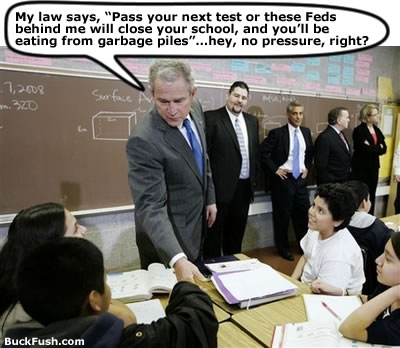Why it’s worth re-reading George W. Bush’s 2002 No Child Left Behind speech

It was on Jan. 8, 2002 that then president George W. Bush signed No Child Left Behind into law, promising a new start for students in low-achieving schools. It was a “historic” moment, he said, and America’s public schools would be all the better for it.
The reality of NCLB never matched Bush’s hopes, in part because the law mandated the impossible goal that all children would be proficient on reading and math tests by 2014, and because President Obama came into office in 2009 and actually took the already identified problems with NCLB — high-stakes tests — and made the situation worse. Now we are at the point where NCLB is almost dead; the Senate passed its successor, the Every Student Succeeds Act, on Wednesday, following last week’s approval by the House. Obama said he will sign the bill, which as my colleague Lyndsey Laytonreports here, will send significant education policy-making power back to states and local districts while maintaining limited federal oversight of education.
But it’s worth taking a look back at that moment when NCLB became law — when Bush put pen to paper at Hamilton High School in Ohio and spelled out his vision for the initiative that he hoped would enshrine him as the “education president” — and the marked similarities to what happened then, and what is happening now.
NCLB was a bipartisan bill that Bush and his Republican supporters in Congress crafted with none other than Sen. Ted Kennedy of Massachusetts, the Democrat that the GOP loved to hate. Later, Kennedy got angry because NCLB was never fully funded, but without him, there might have been no NCLB.
ESSA is a bipartisan effort that would not have succeeded without the collaboration of Republican Sen. Lamar Alexander of Tennessee, the head of the Senate education committee, and Democratic Sen. Patty Murray of Washington, the panel’s ranking member.
NCLB was hailed by Bush as a civil rights achievement because it was designed to force schools to pay attention to slighted populations of students. Current Education Secretary Arne Duncan, who in fact did not get everything he wanted in this bill, still called it a civil rights win for the same reasons. (Critics would argue that neither were.)
NCLB was passed by Congress in December 2001 — just a few months after the Sept. 11 terrorist attacks on the World Trade Center and the Pentagon — and Bush made mention of terrorism in his NCLB speech. The ESSA passed Congress amid a national debate about terrorism.
When NCLB passed, it was hard to find a critical comment, with effusive praise coming from legislators of both parties and various education groups (though there were a few). The praise for ESSA is just as effusive from various constituencies. It is not hard to project that in hindsight, some folks will be sorry they hadn’t paid more attention to ESSA when it was being created, as was true with NCLB.
Here’s Bush’s speech. Read it and see what the hope was vs. today’s reality, in which achievement gaps have not measurably narrowed, school choice has spread but with highly mixed results, and teachers feel as if they have spent years under siege from reformers.
THE PRESIDENT: Thank you all very much.AUDIENCE: U-S-A! U-S-A!THE PRESIDENT: Okay. I know you all are anxious to get back to class. (Laughter.) So please be seated. (Laughter.) Thank you for such a warm welcome. It’s great to be in the home of the Big Blue. (Applause.) Hamilton High School. I want to thank you all for coming. I particularly want to thank my friend, the Governor of the great state of Ohio, Governor Taft, for being here. (Applause.)I want to thank Tracy Miller for being so hospitable. (Applause.) I want to thank all who have come to witness this historic moment. For those of you who have studied the history of our government, you know most bills are signed at the White House. But I decided to sign this bill in one of the most important places in America — a public school. (Applause.)We’ve got large challenges here in America. There’s no greater challenge than to make sure that every child — and all of us on this stage mean every child, not just a few children — (applause) — every single child, regardless of where they live, how they’re raised, the income level of their family, every child receive a first-class education in America. (Applause.)And as you know, we’ve got another challenge, and that’s to protect America from evil ones. And I want to assure the seniors and juniors and sophomores here at Hamilton High School that the effort that this great country is engaged in, the effort to defend freedom and to defend our people, the effort to rout out terrorWhy it’s worth re-reading George W. Bush’s 2002 No Child Left Behind speech - The Washington Post:
